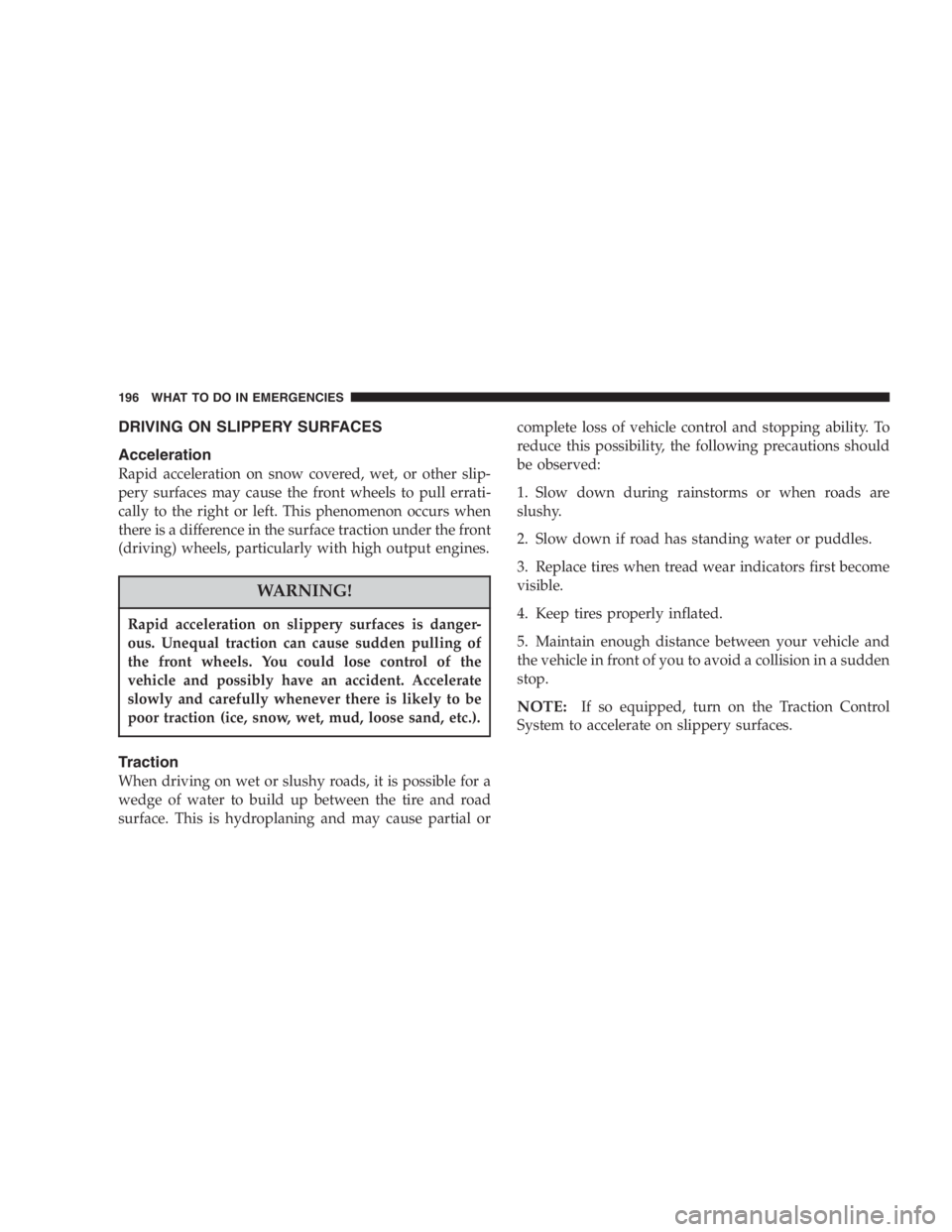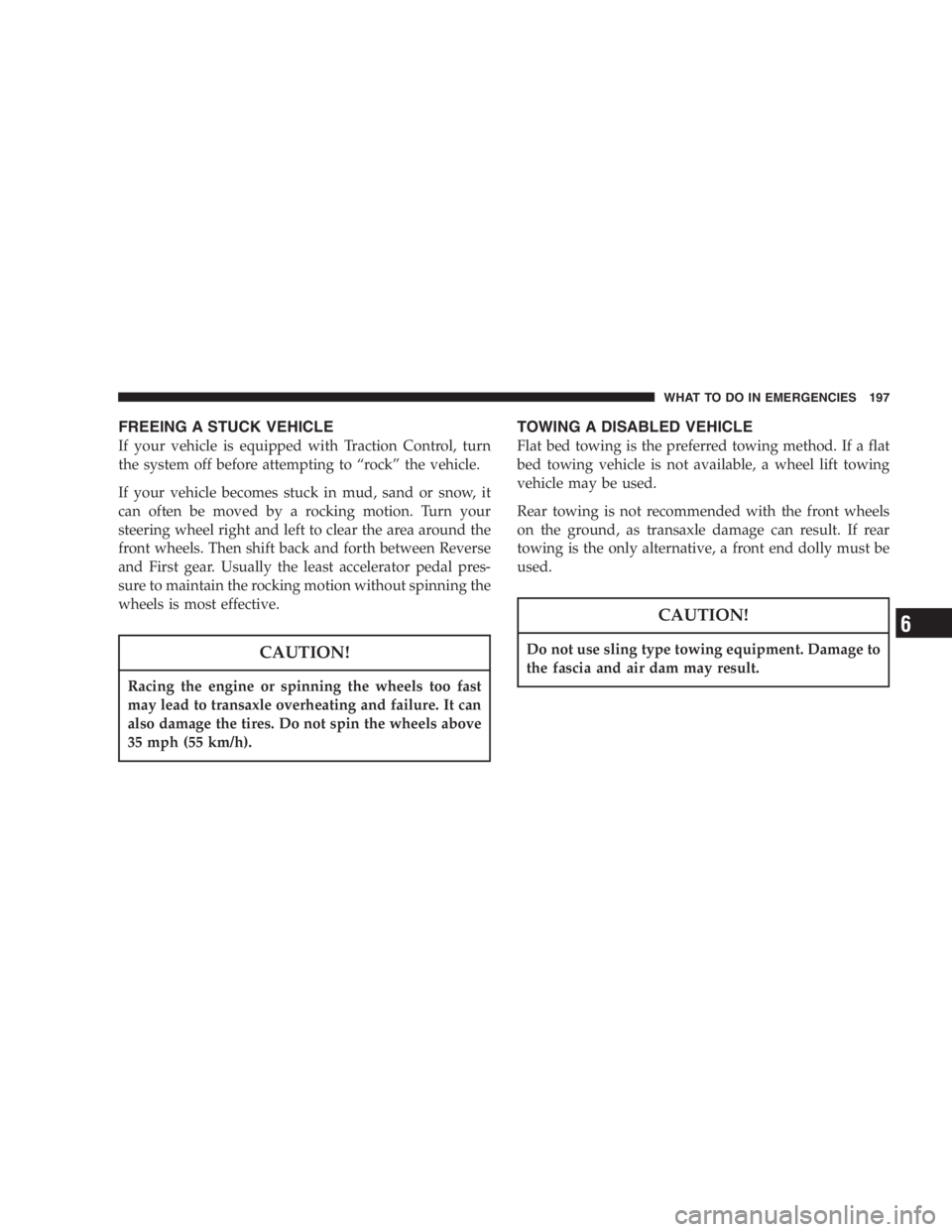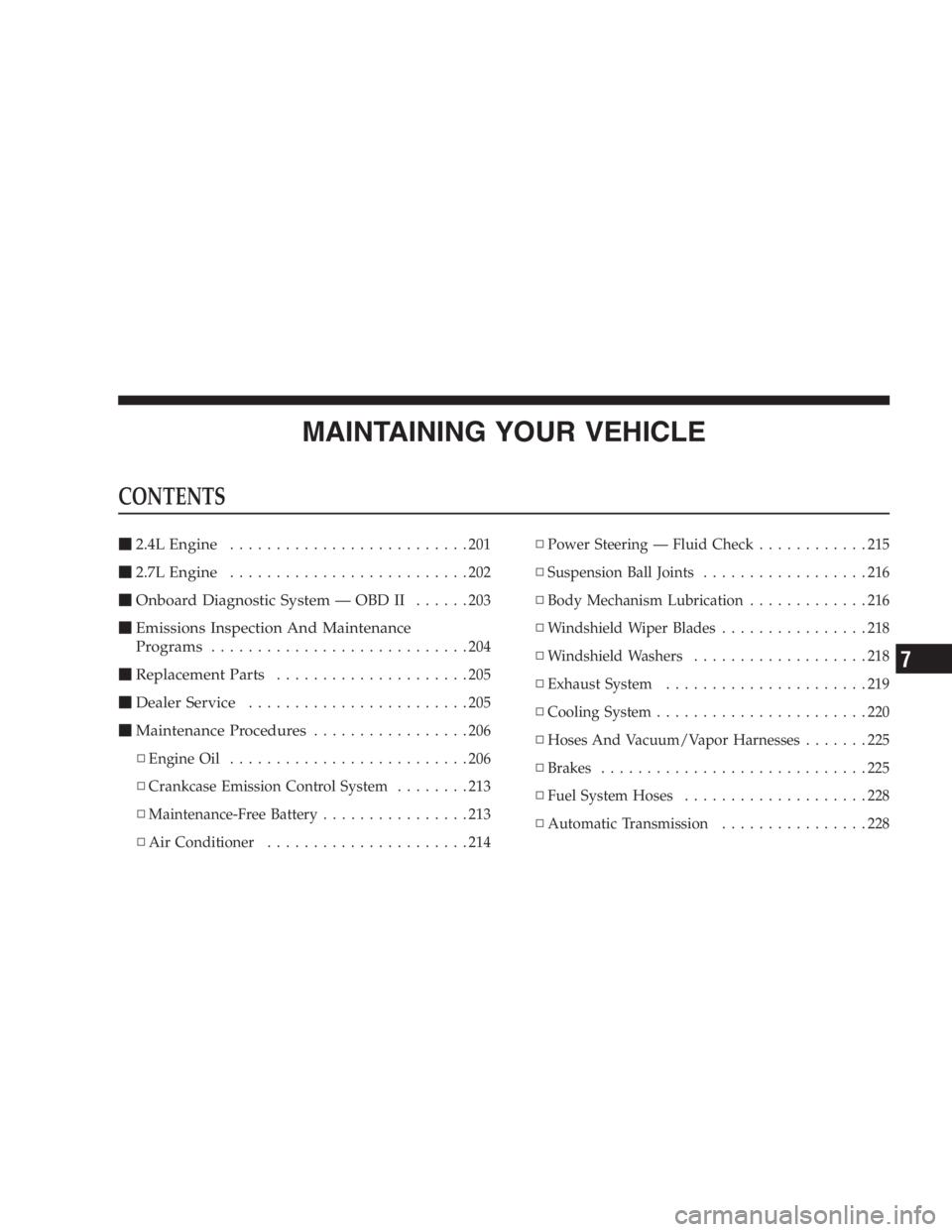Page 196 of 293

DRIVING ON SLIPPERY SURFACES
Acceleration
Rapid acceleration on snow covered, wet, or other slip-
pery surfaces may cause the front wheels to pull errati-
cally to the right or left. This phenomenon occurs when
there is a difference in the surface traction under the front
(driving) wheels, particularly with high output engines.
WARNING!
Rapid acceleration on slippery surfaces is danger-
ous. Unequal traction can cause sudden pulling of
the front wheels. You could lose control of the
vehicle and possibly have an accident. Accelerate
slowly and carefully whenever there is likely to be
poor traction (ice, snow, wet, mud, loose sand, etc.).
Traction
When driving on wet or slushy roads, it is possible for a
wedge of water to build up between the tire and road
surface. This is hydroplaning and may cause partial orcomplete loss of vehicle control and stopping ability. To
reduce this possibility, the following precautions should
be observed:
1. Slow down during rainstorms or when roads are
slushy.
2. Slow down if road has standing water or puddles.
3. Replace tires when tread wear indicators first become
visible.
4. Keep tires properly inflated.
5. Maintain enough distance between your vehicle and
the vehicle in front of you to avoid a collision in a sudden
stop.
NOTE:If so equipped, turn on the Traction Control
System to accelerate on slippery surfaces.
196 WHAT TO DO IN EMERGENCIES
Page 197 of 293

FREEING A STUCK VEHICLE
If your vehicle is equipped with Traction Control, turn
the system off before attempting to“rock”the vehicle.
If your vehicle becomes stuck in mud, sand or snow, it
can often be moved by a rocking motion. Turn your
steering wheel right and left to clear the area around the
front wheels. Then shift back and forth between Reverse
and First gear. Usually the least accelerator pedal pres-
sure to maintain the rocking motion without spinning the
wheels is most effective.
CAUTION!
Racing the engine or spinning the wheels too fast
may lead to transaxle overheating and failure. It can
also damage the tires. Do not spin the wheels above
35 mph (55 km/h).
TOWING A DISABLED VEHICLE
Flat bed towing is the preferred towing method. If a flat
bed towing vehicle is not available, a wheel lift towing
vehicle may be used.
Rear towing is not recommended with the front wheels
on the ground, as transaxle damage can result. If rear
towing is the only alternative, a front end dolly must be
used.
CAUTION!
Do not use sling type towing equipment. Damage to
the fascia and air dam may result.
WHAT TO DO IN EMERGENCIES 197
6
Page 199 of 293

MAINTAINING YOUR VEHICLE
CONTENTS
�2.4L Engine..........................201
�2.7L Engine..........................202
�Onboard Diagnostic System—OBD II......203
�Emissions Inspection And Maintenance
Programs
............................204
�Replacement Parts.....................205
�Dealer Service........................205
�Maintenance Procedures.................206
▫Engine Oil..........................206
▫Crankcase Emission Control System........213
▫Maintenance-Free Battery................213
▫Air Conditioner......................214▫Power Steering—Fluid Check............215
▫Suspension Ball Joints..................216
▫Body Mechanism Lubrication.............216
▫Windshield Wiper Blades................218
▫Windshield Washers...................218
▫Exhaust System......................219
▫Cooling System.......................220
▫Hoses And Vacuum/Vapor Harnesses.......225
▫Brakes.............................225
▫Fuel System Hoses....................228
▫Automatic Transmission................228
7
Page 200 of 293
▫Appearance Care And Protection From
Corrosion...........................230
�Fuses...............................235
▫Underhood Fuses (Power Distribution Center) . 235
▫Interior Fuses........................235
�Vehicle Storage........................237
�Replacement Light Bulbs................238
�Bulb Replacement......................238
▫Headlight Bulb Replacement.............238
▫Park, Turn Signal, Sidemarker Bulb
Replacement.........................240▫Fog Light Bulb Replacement.............241
▫Center Stoplight Bulb Replacement.........242
▫Rear Light Bulb Replacement.............243
▫License Plate Bulb Replacement...........243
▫Headlight Aiming.....................244
�Fluids And Capacities...................244
�Recommended Fluids, Lubricants And Genuine
Parts
...............................245
▫Engine.............................245
▫Chassis............................246
200 MAINTAINING YOUR VEHICLE
Page 201 of 293
2.4L ENGINE
2.4L Engine Compartment
MAINTAINING YOUR VEHICLE 201
7
Page 202 of 293
2.7L ENGINE
2.7L Engine Compartment
202 MAINTAINING YOUR VEHICLE
Page 203 of 293

ONBOARD DIAGNOSTIC SYSTEM—OBD II
Your vehicle is equipped with a sophisticated onboard
diagnostic system called OBD II. This system monitors
the performance of the emissions, engine, and automatic
transmission control systems. When these systems are
operating properly, your vehicle will provide excellent
performance and fuel economy, as well as engine emis-
sions well within current government regulations.
If any of these systems require service, the OBD II system
will turn on the“Malfunction Indicator Light.”It will
also store diagnostic codes and other information to
assist your service technician in making repairs. Al-
though your vehicle will usually be drivable and not
need towing, see your dealer for service as soon as
possible.CAUTION!
•Prolonged driving with the“Malfunction Indica-
tor Light”on could cause further damage to the
emission control system. It could also affect fuel
economy and driveability. The vehicle must be
serviced before any emissions tests can be per-
formed.
•If the“Malfunction Indicator Light”is flashing
while the engine is running, severe catalytic con-
verter damage and power loss will soon occur.
Immediate service is required.
MAINTAINING YOUR VEHICLE 203
7
Page 204 of 293

EMISSIONS INSPECTION AND MAINTENANCE
PROGRAMS
In some localities, it may be a legal requirement to pass
an inspection of your vehicle’s emissions control system.
Failure to pass could prevent vehicle registration.
For states which have an I/M (Inspection and
Maintenance) requirement, this check verifies the
following: the MIL (Malfunction Indicator Lamp)
is functioning and is not on when the engine is running,
and that the OBD (On Board Diagnostic) system is ready
for testing.
Normally, the OBD system will be ready. The OBD
system maynotbe ready if your vehicle was recently
serviced, if you recently had a dead battery, or a battery
replacement. If the OBD system should be determined
not ready for the I/M test, your vehicle may fail the test.
Your vehicle has a simple ignition key actuated test
which you can use prior to going to the test station. To
check if your vehicle’s OBD system is ready, you must do
the following:
1. Insert your ignition key into the ignition switch.2. Turn the ignition to the ON position, but do not crank
or start the engine.
3. If you crank or start the engine, you will have to start
this test over.
4. As soon as you turn your key to the ON position, you
will see your MIL symbol come on as part of a normal
bulb check.
5. Approximately 15 seconds later, one of two things will
happen:
a. The MIL will flash for about 10 seconds and then
return to being fully illuminated until you turn off
the ignition key or start the engine. This means that
your vehicle’s OBD system isnot readyand you
shouldnotproceed to the I/M station.
b. The MIL will not flash at all and will remain fully
illuminated until you turn off the ignition key or
start the engine. This means that your vehicle’s OBD
system isreadyand you can proceed to the I/M
station.
204 MAINTAINING YOUR VEHICLE